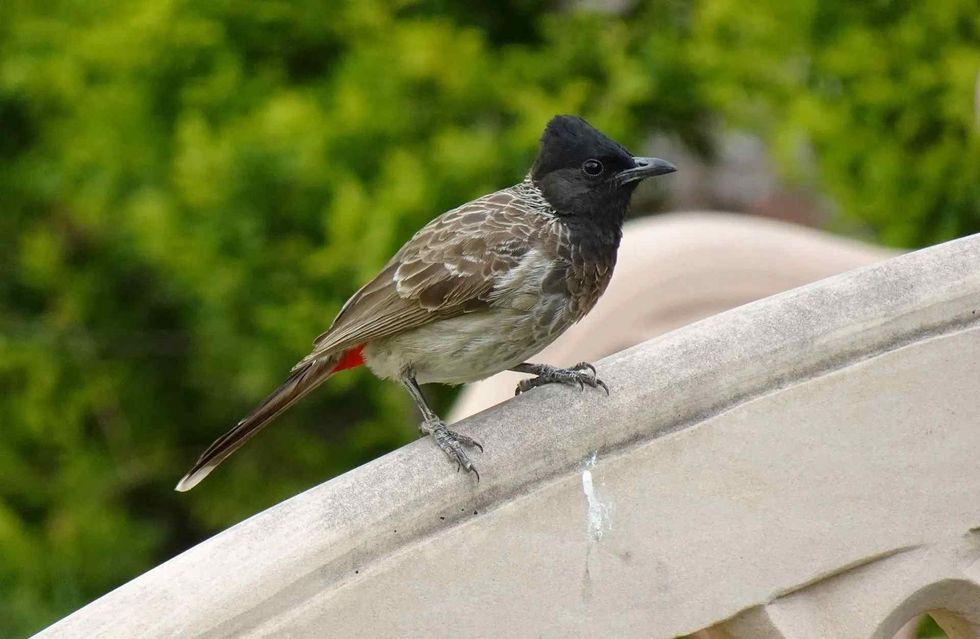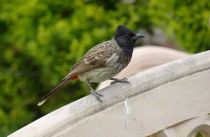The red-vented bulbul (Pycnonotus cafer) is a species of bird found in the native range of Asia. This includes southern India, Pakistan, Burma, southern China, Nepal, Myanmar, and Sri Lanka.
They have also been introduced to non-native lands like the United Arab Emirates, and New Zealand as well as many Pacific islands including Fiji, Hawaii, Samoa, and Tonga. Their distribution is still varied and in some countries, these introduced birds could not survive.
Red-vented bulbuls live in scrub habitats or open forests and have around eight sub-species. They are close relatives of the red-whiskered bulbul and belong to the same family.
The conservation status of this species is Least Concern and their population is steady. Red-vented bulbuls are considered an invasive wild species in some places because they cause a lot of damage to fruit crops.
They can also spread seeds of many invasive plants as they get stuck on their coat. The red-vented bulbul species is identified by its short yet prominent crest in black.
The rump is white and the vent is red. The black tail of this bulbul bird is tipped in white and the head is darker or black as compared to the body.
Scroll down to read some very interesting facts about the red-vented bulbul. If you like reading about birds, you can also check out the bee-eater and the toco toucan.
Red-Vented Bulbul Interesting Facts
What type of animal is a red-vented bulbul?
The red-vented bulbul (Pycnonotus cafer) is a species of bird commonly found in southern Asia.
What class of animal does a red-vented bulbul belong to?
The red-vented bulbul belongs to the class of birds with the Pycnonotus genus of the Pycnonotidae family. The scientific name is Pycnonotus cafer.
How many red-vented bulbuls are there in the world?
The current population of red-vented bulbuls is unknown, but their numbers as well as distribution range are steadily increasing. This means that the Pycnonotus cafer species is not in any immediate danger.
Where does a red-vented bulbul live?
Red-vented bulbuls are found in open forests of their native range in southern Asian countries like southern India, Pakistan, Burma, southern China, Nepal, Myanmar, and Sri Lanka. This species has also been introduced to areas outside of natural distribution or native habitat.
Some of these places are the United Arab Emirates, New Zealand as well as many Pacific islands including Fiji, Hawaii, Samoa, and Tonga. Their distribution in non-native areas is varied and in some places, this species could not be successfully introduced.
What is a red-vented bulbul's habitat?
The red-vented bulbul habitat includes areas rich with vegetation like dry scrubs, open forests, plains, parks, gardens, and cultivated agricultural land. They are versatile, stubborn, and can live well even in an urban setting.
Who do red-vented bulbuls live with?
Red-vented bulbuls are a social bird species that tend to fly together in flocks. During the breeding season, they can be seen in pairs.
How long does a red-vented bulbul live?
The lifespan of an average red-vented bulbul (Pycnonotus cafer) can be about 11 years in the wild.
How do they reproduce?
The red-vented bulbul is known to breed from June to September but some can also breed all year round. The nest for eggs is made out of dry twigs, spider webs, or any other foreign material like metal wires at a height of 6.6–9.8 ft (2-3 m).
The main nesting location of Pycnonotus cafer is usually dry shrubs, other secure vegetation, or trees in the wild. Red-vented bulbul females lay two to three eggs and can have multiple clutches in one year. Both parents of this bird family incubate the eggs.
The incubation period does not last more than 11 to 14 days. After eggs are hatched, both parent species take turns feeding hungry chicks.
What is their conservation status?
The conservation status of red-vented bulbul (P. cafer) is listed as Least Concern. They have an increasing population and are considered to be an invasive species in some areas due to the damage they cause to fruit crops.
Red-Vented Bulbul Fun Facts
What do red-vented bulbuls look like?
The red-vented bulbul is easily identified by its short black crest that gives a squarish appearance. The body is dark brown with a scaly pattern and the black tail is tipped white. The Himalayan races have an extended black hood that goes up to the mid-breast.
These birds have a reddish hue on the underside of the tail. They also have dark bill, eyes, and legs.
Both sexes are similar in appearance. Red-vented bulbul eggs are pale pink with dark red spots. They also have a natural hybrid with white-cheeked bulbuls and have offspring with yellow-orange or pink vents.
How cute are they?
Red-vented bulbul birds have a crest on their head which gives an appearance of a Roman helmet. Their head is black and different from the rest of the body.
They are also a common cage bird and they are easy to tame, docile, and friendly if not stressed. These birds are small, full of fluffy feathers, and look very cute!
How do they communicate?
Red-vented bulbuls can communicate using a series of vocal sounds like chirps, singing, tweeting, and screaming. They can also use body language like puffing feathers to communicate.
The red-vented bulbul singing sounds like a series of high-pitched chirping that is pleasant to hear. They have different types of calls used for various purposes like greeting and alarming in case of predators.
How big is a red-vented bulbul?
The average size of a red-vented bulbul is 8.25 in (21 cm). They are about twice the size of a hummingbird and the same size as a red-whiskered bulbul.
How fast can a red-vented bulbul move?
The average speed of Pycnonotus cafer birds is not yet estimated.
How much does a red-vented bulbul weigh?
The weight of a red-vented bulbul is about 0.9-1.5 oz (26-45 g).
What are the male and female names of the species?
There are no names for male and female bulbul birds.
What would you call a baby red-vented bulbul?
A baby red-vented bulbul is called a chick or a fledgling.
What do they eat?
As an omnivore bird, the red-vented bulbul diet includes fruits, flower petals, and nectar but they have also been spotted eating insects or lizards. They can also eat wasps, bees, and cicadas.
These birds mainly eat fruits like plums, lychees, papaya, berries, banana, apples, and alfalfa leaves. Predators of red-vented bulbul birds are feral cats, crows, snakes, Calotes lizards, owlets, and shikra.
Are they poisonous?
Red-vented bulbul birds are not poisonous species. They are pretty harmless and easy to tame. These bulbul birds can be aggressive to other birds in the area. Red-vented bulbuls are considered to be an invasive pest in a lot of agricultural areas because they can destroy a lot of fruit crop plantations like plum and apple.
Would they make a good pet?
The red-vented bulbul has been domesticated in many areas of India and carried around in bazaars or shops. They are a popular cage bird in many other parts of the world as well.
While they are tame and docile birds, it is not the best idea to put them in cages. As birds, bulbuls belong in the sky as well.
They would make a good pet as long as their freedom is guaranteed! They are also friendly birds, curious about people, and will be docile if not in a crowded environment or stressed.
Did you know...
In earlier times, the red-vented bulbul was a fighting bird for human entertainment. They were closed in cages and would pluck the red feathers of the opponent during fights.
How does the red-vented bulbul affect the environment?
Red-vented bulbul birds are known to eat fruits and spread seeds of invasive plants like Miconia, ivy gourd, and false kava. This makes them a pest that aids in growing populations of invasive plants.
Red-vented bulbul birds can also damage fruit crops in various agricultural lands like beans, plums, apples, tomatoes, and peas.
They have also led to an increase in the population of white morph monarch butterflies in Hawaii because they feed on orange morphs. The red-vented bulbul is also aggressive and as an introduced bird species, they can alter the numbers of naturally present birds in areas like New Zealand.
How can you tell if a red-vented bulbul is male or female?
Both male and female red-vented bulbuls look very similar. The only difference is that males are a little bit bigger than females. This makes it difficult to differentiate between males and females.
Here at Kidadl, we have carefully created lots of interesting family-friendly animal facts for everyone to discover! Learn more about some other birds including umbrellabird, and grey partridge.
You can even occupy yourself at home by coloring in one of our free printable red-vented bulbul coloring pages.










